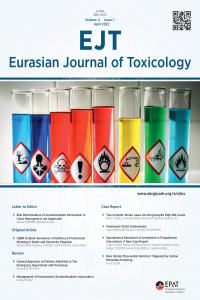Evaluation of the Relationship of Serum Digoxin Levels with Demographic Data
Digoksin zehirlenmesi, digoksin seviyeleri, demografik veriler, acil servis
Evaluation of the Relationship of Serum Digoxin Levels with Demographic Data
Digoxin intoxication, digoxin levels, demographic data, emergency service,
___
- 1) Ochs HR, Grube E, Greenblatt DJ, Arendt R, Bodem G. Pharmacokinetics and pharmacodynamics of intravenous digoxin and digitoxin. Klinische Wochenschrift, 1981; 59(16):889-97.
- 2) Kayaalp O. Medical Pharmacology for Rational Therapy (10th edition). Ankara: Hacettepe-Taş Kitapçılık. 2002.
- 3) Kepez A, Kabakcı G. Treatment of Heart Failure, Hacettepe Medical Journal, 2004; 35 (2):69-81.
- 4) Çiftçi E, Aydın S. Toxicological Evaluation of Digital Glycosides in Congestive Heart Failure, FABAD J. Pharm. Sci, 2018; 43(3):263-77.
- 5) Dec G W. Digoxin Remains Useful in the Management of Chronic Heart Failure, The Medical Clinics of North America, 2003; 87 (2):317-37.
- 6) Satar S, Acilde Klinik Toksikoloji. Akademisyen Kitabevi. Ankara, Türkiye, 2009.
- 7) Vyas A, Bachani N, Thakur H, Lokhandwala Y. Digitalis toxicity: ECG vignette. Indian Heart Journal, 2016; 68(2):223-5.
- 8) Boyle JS, Kirk MA. Digitalis Glycosides. In:Tintinalli JE, Tintinalli's Emergency Medicine, A Comprehensive Study Guide, seventh edition, New York, McGraw Hill, 2010:1260-4.
- 9) Gerede D M, Koboev R, Çağlar N, Kılıçkap M, Erol Ç. Evaluation and Clinical Significance of Factors Affecting the Serum Digoxin Levels in Patients Taking Digoxin. MN Kardiyoloji, 2015; 22:30-6.
- 10) Sarı I, Çavuşoğlu Y, Temizhan A, Yılmaz MB, Eren M. ESC and ACC/AHA/HFSA Heart Failure Guideline Updates: Changes, Similarities, Differences, and Unresolved Isssues. Turkish Society of Cardiology Ars, 2016;44(8):625-36.
- 11) Ahmed A, Rich MW, Love TE, et al. Digoxin and Reduction in Mortality and Hospitalization in Heart Failure: A Comprehensive Post Hoc Analysis of the DIG Trial. Eur Heart J, 2006; 27:178-86.
- 12) Yancy CW, Jessup M, Bozkurt B, Butler J, Casey DE, Drazner MH, et al. ACCF/AHA Guide¬line for the Management of Heart Failure: A Report of the American College of Cardiology Foundation/American Heart Association Task Force on Practice Guidelines. Circulation, 2013; 128 (16): 240-327.
- 13) Francke DE, Bioavailability of Digoxin. The Annals of Pharmacotherapy, 2006; 40(6):1185.
- 14) Roberts DM, Gallapatthy G, Dunuwille A, Chan BS. Pharmacological Treatment of Cardiac Glycoside Poisoning, British journal of Clinical Pharmacology, 2016; 81(3):488-95.
- 15) Aslantaş U, Yıldırım S, Bayram MK, Yurtseven A, Çimen T, Doğan M, et al. Digoxin Toxicity in Therapeutic Serum Levels. Mustafa Kemal Üniv Tıp Derg 2015; 6(23): 21-6.
- 16) Moten M, Anand IS, Sarma RJ, Babb JD. The Effect of Digoxin on Mortality and Morbidity in Patients with Heart Failure. New England Journal of Medicine, 1997; 8(336):525:33.
- Yayın Aralığı: Yılda 3 Sayı
- Başlangıç: 2019
- Yayıncı: Acil Tıp Uzmanları Derneği
Serdar ÖZDEMİR, Kamil KOKULU, Abdullah ALGIN, Hatice Şeyma AKÇA
Ticagrelor Intoxication: Overdose in a Suicidal Attempt
Sertaç GÜLER, Dilber ÜÇÖZ KOCAŞABAN
Plasma Lactate Levels in Carbon Monoxide Intoxication, Can be Used at First Step?
Sinem DOĞRUYOL, İlker AKBAŞ, Erdal TEKİN
A Rare Cause of Serotonin Syndrome: Chronic Olanzapine Use
Seda DAĞAR, Emine EMEKTAR, Meral TANDOĞAN, Şeref Kerem ÇORBACIOĞLU, Hüseyin UZUNOSMANOĞLU, Yunsur ÇEVİK
Evaluation of the Relationship of Serum Digoxin Levels with Demographic Data
Hatice Şeyma AKÇA, Abdullah ALGIN, Serdar ÖZDEMİR, Kamil KOKULU, İbrahim ALTUNOK
The Effects of Moon Phases on Suicide Attempts
Avni Uygar SEYHAN, Nihat Müjdat HÖKENEK, Nurhayat BAŞKAYA, Erdal YILMAZ, Semih KORKUT, Hatice Kübra ÖNDER KARAGÖZ, Huda ALMADHOUN
Acute Myocardial Infarction Following 5-Fluorouracil Use
Şükrü GÜRBÜZ, Muhammed EKMEKYAPAR, Hakan OĞUZTÜRK, Neslihan YÜCEL, M. Gökhan TURTAY, Serdar DERYA
